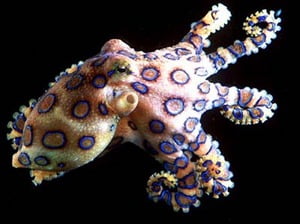The isolation of Australia for 55 million years has created a sanctuary for plants, animals and birds, and some of the oldest living plants and animals can be found here. Australia is a staggeringly beautiful country and one that everyone should visit at least once in their lives. But beneath Australia’s beauty lies also great danger. Besides the Great White Shark, here are three of Australia’s deadliest sea creatures:
The Blue-Ringed Octopus
If you happen to be a diver, fancy snorkeling around reefs, or simply enjoy tidal pools, don’t get too curious when poking around those rocks! Because burrowed deep in those crevasses and holes lurks one of Australia’s deadliest creatures — the blue-ringed octopus.
This small creature is no larger than a golf ball, but packs enough poison to kill 26 adult humans in mere minutes. It is found in Southwestern Australia, from Southern Queensland to Northern Tasmania.
The blue-ringed octopus can be found in depths that range from 0 to 20 meters and feeds primarily on crabs, which is very lucky for us. The octopus is kind enough to warn us when it is feeling threatened and poised to attack. It does this by lighting up its body with electric blue rings. If you happen to be near this octopus once it has lit up, do not touch it and get as far away as you can!
If you have the misfortune to get bitten by one of these guys, the good news is that its bite will not hurt you and you may not even feel it. The bad news? This octopus has just injected a neuromuscular paralyzing venom into your body that contains maculotoxin, a poison more violent than any found in a single land animal.
Would you like the rest of the bad news now? Okay then. There is no known antidote to the blue-ringed octopus bite. Within moments you will feel nauseous, and in just a few seconds you may very well also be completely blind. You will lose your sense of touch, your speech and your ability to swallow. Within just 3 minutes, paralysis will set in and your body will go into respiratory arrest. Not too bad for a creature that is smaller than your fist.
I’m sorry to say that the only hope a person has for survival if they are bitten by the blue-ringed octopus is to have pressure immobilization and prolonged artificial respiration. Mechanical ventilation may be required later, that is if you are lucky enough to make it to the hospital alive. The main problem here is that once you have been bitten, it is generally impossible to speak and so letting someone around you know how you’re feeling may be more than just a little difficult. There may be no known antivenin in Australia, but if you do have some help breathing the poison will wear off in 24 hours and leave no side effects.
Box Jellyfish
The box jellyfish is another deadly creature that can be found in the tropical waters of Queensland. The season for the box jellyfish usually begins in October and ends in April.
Box jellyfish are pale blue and transparent and either bell or cube-shaped with four sides, which is what gives them their name. These jellyfish like calm waters and a high tide, and this is when they are most likely to head for the shore.
If you are stung by a box jellyfish, there is very little chance of survival unless you are treated immediately. The pain that is suffered is said to be so excruciating that most people go into shock and drown before they even reach the shore. If you do make it to the shore with some assistance, however, domestic vinegars should be poured over the tentacles to inactivate the stinging cells. The tentacles can then be removed, and artificial respiration and cardiac massage will probably also be needed.
Stone Fish
Another critter that lurks in the waters of Queensland and other parts of Australia is the stone fish. The stone fish feeds on small fish and shrimps and lurks in shallows camouflaged as a rock, just waiting for an unsuspecting tourist’s foot to step on its deadly back spines. Its sting causes rapid swelling that results in death of the skin tissues and the severity of the sting all depends upon the deepness of penetration and the number of spines that has penetrated the flesh. Shock, temporary paralysis, and muscle weakness are all symptoms that may lead to death if the subject is not treated.
The stone fish’s sting is reputed to be one of the most excruciatingly painful experiences that a person can have and people have been known to uncontrollably bite their own tongues off due to the severity of the pain.
Sources: Wikipedia, www.barrierreefaustralia.com



